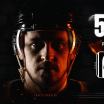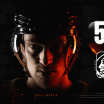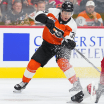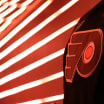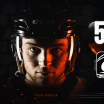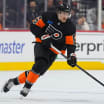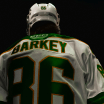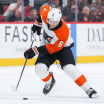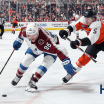The Flyers announced today that Rick Tocchet and Paul Holmgren are the two newest inductees into the Flyers Hall of Fame. Both will be inducted during a special ceremony at the Wells Fargo Center on Nov. 16, 2021, before the Flyers play the Calgary Flames.
The Flyers Hall of Fame Voting Committee named Tocchet and Holmgren among a field of six finalists selected by a separate Nominating Committee. The other finalists were Mark Recchi, Simon Gagne, Bob "the Hound" Kelly and Lou Nolan.
Here's a look at the two newest inductees.
Newest Flyers Hall of Famers: Rick Tocchet and Paul Holmgren
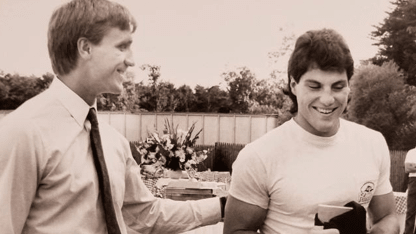
RICK TOCCHET
One of the toughest power forwards of his era, hard work and determination enabled Rick Tocchet to become a perennial overachiever in the National Hockey League in an 1,144-game career that included separate stints with the Flyers at the beginning (1984-85 to 1991-92) and end (1999-2000 to 2001-2002) of his playing career.
The Scarborough, Ontario native was originally a sixth-round pick (121st overall) in the 1983 NHL Draft. Little did the rugged Sault Ste. Marie Greyhounds winger suspect at the time that he'd make it to the NHL just one year later, bypassing the American Hockey League.
"I just remember as a kid, being 19 years old, and [legendary Flyers public relations director] Joe Kadlec taking me to the Spectrum for the first time, as a draft pick. I remember looking out at either side of the Walt Whitman Bridge at how big Philly was and it was like, 'Where am I?'' And that area, the people there, became like family to me. I grew up there," Tocchet recalled in an episode of Flyers Daily.
"I still have a lot of friends in the Philadelphia area. They really helped me. You know, when you're 19 years old and you're going to a big city, it can be overwhelming. Ed Snider had that family-like atmosphere, which really helped me a lot. I owe them a lot for getting me to the career I ultimately had."
Tocchet was not a natural-born star in the NHL, nor did success come overnight despite graduating to the world's top league at the tender age of 20. It was his intense competitiveness and work ethic was what turned him from a third-line caliber forward best known for his fighting prowess into one the NHL's top power forwards of the late 1980s to mid 1990s. He reached the Stanley Cup Final with the Flyers in 1985, 1987 (falling just one win short of hockey's ultimate prize) as well as the Wales Conference Final in 1989.
At the time, it was a whirlwind of activity and an emotional rollercoaster for everyone involved. Only years later has Tocchet gained full perspective on what an extraordinary era it was.
The Flyers were the youngest team in the NHL, with a ultra-intense rookie head coach in Mike Keenan, when Tocchet made his NHL debut in 1984-85. He forged close bonds with a host of teammates, especially the likes of the late Peter Zezel, Murray Craven and Derrick Smith.
The team as a whole had to rally around each other following the tragic death of Vezina Trophy winning goalie Pelle Lindbergh in November 1985, and their shared grief over Lindbergh, as well as the two runs to the Cup Finals, left everyone spent emotionally.
"[Lindbergh's death] really hit me a day or two later. I remember right afterward that Mike Keenan had everyone over at his house, kind of like a group therapy talk about it. I think it was the second or third night, and it really hit me. I broke down. My teammates were unbelievable. Dave Poulin was our captain and he did an incredible job to keep our group together. That was a very tight-knit group," Tocchet recalled on Flyers Daily.
"I've gotta tell you. I played 18 years and had a lot of good memories, Stanley Cups and stuff, but that group was the closest I've ever been involved with. Just incredible people. And a hard-working group. We dealt with all of it together. We had strong leadership and a strong organization."
The 1987 run, backstopped by rookie goalie Ron Hextall, was the culmination of that era of Flyers hockey. Tocchet made a statement by his playoff performance -- 11 goals and 21 points -- that he'd arrived as a true impact player in the NHL. Ultimately, the injury-riddled Flyers dropped a hard-fought Game 7, 3-1, to the Edmonton Oilers at the height of their dynasty.
"I'll go golfing sometimes with Wayne Gretzky and Paul Coffey, who've become good friends of mine, and I'll tell them, 'We would have won Game 7 if Timmy Kerr was able to play.' He was a perennial 50-goal scorer, and he scored a power play goal almost every game. He would have scored in that game. They kind of laugh about it and bust on me a little. But there's no doubt how great that Edmonton team was," Tocchet said.
Although he didn't always understand or agree with Keenan's methods of coaching his personnel, Tocchet says in retrospect that the coach got the most out of the club. A host of Keenan's players, both in Philadelphia and in subsequent coaching stops, played the best hockey of their career during their time playing for "Iron Mike."
"The thing with Keenan is that I think, for that era, we were the best-conditioned team in the league. He put us to the grindstone, but we were in great shape and that's something I will always remember," Tocchet said.
The Flyers of the mid-to-late 1980s only had one player -- defenseman Mark Howe -- who ultimately earned a place in the "big" Hockey Hall of Fame in Toronto. There was plenty of talent and depth but not as much star power as the Oilers dynasty of the mid-1980s to 1990 or the New York Islanders dynasty of 1980 to 1983. During his Flyers years, Tocchet learned lessons that he late applied to coaching: chemistry, depth and work ethic are indispensable.
"I really believe you have to have four lines, and everyone has to fit in the puzzle. Sometimes you can have the best players, but it doesn't work. You have to have the best total puzzle. Our teams, everyone was a puzzle piece, and guys just accepted their role. That was the biggest key. Everybody wants more, and I understand that, but you've got to accept being a team player," Tocchet said.
Tocchet's own niche expanded over time. The term "power forward" first came in vogue leaguewide during Tocchet's heyday, referring to players who combined a tenacious physical style of play, a willingness to drop the gloves will all comers and goal-scoring prowess to top it off. Tocchet became one of the very best power forwards in the NHL, along with the likes of Cam Neely and Brendan Shanahan.
Tocchet achieved his first 20-goal season in his third NHL campaign. He just kept improving from there. "Tocch" scored 31 goals in 1987-88 and then, in 1988-89, attained his first of three 40-goal campaigns.
During the mid-to-late 1980s, Tocchet was one of the team's resident heartthrobs along with Peter Zezel. Tocchet was named Flyers captain on Oct. 2, 1991 and served in that capacity until he was traded to the Pittsburgh Penguins on Feb. 19, 1992 in a blockbuster trade that brought Mark Recchi to the Flyers. Tocchet went on to win the Stanley Cup with the Penguins that spring and achieved his lone 100-point season (48g, 61a) in 1992-93.
After spending parts of three seasons with the Penguins, Tocchet had stints with the LA Kings, Boston Bruins, Washington Capitals (briefly) and the Coyotes before he was reacquired by the Flyers.
Tocchet returned to the Flyers on March 8, 2000 in a one-for-one trade with the Phoenix Coyotes that brought former Legion of Doom right wing Mikael Renberg's second Flyers stint to an end. Tocchet was a valuable addition down the stretch and the playoffs in 1999-2000.
The hard-nosed veteran notched 11 points in 18 playoff games, as the team fell a 2-1 Game 7 loss to New Jersey short of a return trip to the Stanley Cup Final for the first time since 1997.
"That was another great group, when I came back to the Flyers. When I see those guys, we always talk about, 'Wow, just one inch here, one inch there.' You know, just little things. We had a team that was good enough to win. I think we could have beat Dallas [in the Stanley Cup Final]. There's a lot of what ifs. But I gotta tell you, that year, I had such a blast. I was an older guy, on the back-nine of my career, but it was a great time. Just seeing those guys, like Craig Berube, Keith Jones, Chris Therien, we had a very close team," Tocchet recalled.
"There was a lot of stuff going on, like with Eric Lindros getting hurt and wondering if he was going to come back or not, we dealt with a lot. Brian Boucher coming into his own. I mean, it was a real good game. Patrik Elias scoring late in the [seventh] game, kind of broke our hearts. But, you know, I look back at Game 5. We [came in leading three games to one but] just weren't ready to play. We came in, and we were kind of distracted and stuff. That was a game we just gave 'em. Then we lose it in seven."
For his two-stint Flyers career, Tocchet scored 232 goals (tied for 10th in franchise history) and 508 points in 621 regular season games. He is franchise's all-time leader in penalty minutes (1,817). In 95 career playoff games, he produced 27 goals, 33 assists, 60 points and 349 penalty minutes. He is also the all-time franchise leader in Gordie Howe Hat Tricks (nine).
Following his playing days, Tocchet went on to careers in coaching and broadcasting. He was elected to the Philadelphia Sports Hall of Fame in 2020.
PAUL HOLMGREN
This will be a double induction year for Paul Holmgren. In December, he will be inducted in the United States Hockey Hall of Fame as a member of their Class of 2021.
Born on December 2, 1955 in St. Paul, Minnesota. "Homer" holds the unique distinction of being the only person in franchise history to serve the organization as a player, assistant coach, head coach, assistant general manager, general manager and club president. He now serves as a senior advisor.
Holmgren began skating as a toddler and, along with older brother Mark, was playing in a youth hockey league by age six. He was a two-sport athlete at Harding High School in St. Paul, playing football (offensive guard) as well as hockey.
In 1973-74, he played for the St. Paul Vulcans of the Midwest Junior Hockey League in 1973-74. The promising young forward was selected to be part of the US junior national team to compete in the 1974 World Junior Championships - which had not yet gained status as an "official" tournament sanctioned by the International Hockey Federation - in Leningrad. The Americans finished fifth.
The player was selected by the Edmonton Oilers in the third round (38th overall) of the 1974 World Hockey Association (WHA) Draft. The Flyers selected the 6-foot-3, 210-pound right winger in the sixth round (108th overall) of the 1975 NHL Draft.
Already an aggressive player who willingly initiated and took contact, Holmgren racked up 108 penalty minutes in 37 games for the University of Minnesota in 1974-75 while also posting 31 points.
Before joining the Flyers, Holmgren split most of the 1975-76 season between the Johnstown Jets of the infamous North American Hockey League - the team and league that inspired the Charlestown Chiefs in "Slap Shot" - and the WHA's St. Paul Saints, who had purchased his rights from the Oilers.
While with Johnstown, his teammates included Bruce Boudreau, brothers Jeff and Steve Carlson (who portrayed two of the "Hanson brothers" in Slap Shot) and Dave "Killer" Hanson (who was the inspiration for Slap Shot's Dave "Killer" Carlson character and portrayed the Jack Carlson inspired character called Jack Hanson).
The Saints experienced severe financial difficulty and were on the brink of folding when Holmgren joined the Flyers late in the 1975-76 season. He played six games for the American Hockey League's Richmond Robins (four goals, four assists, eight points, 23 penalty minutes) and made his NHL debut for the Flyers.
Near-tragedy struck soon after his arrival. Suffering an eye injury in an AHL game, Holmgren was called up to the Flyers but the situation grew more serious.
"I got called up to the Flyers and my eye continued to get worse," Holmgren recalled to the late Jay Greenberg.
"I played my very first game against the New York Rangers and the next day we flew to Boston. We were going to play a Saturday afternoon game against the Bruins. On Friday night, we had a team meeting that Fred Shero always planned. Barry Ashbee and Bob Clarke grabbed me and rushed me to the hospital. They ended up having to do emergency surgery on my eye. I had a corneal laceration that had to be repaired.
"During the operation, I had some sort of allergic reaction to the anesthesia and apparently my heart stopped for some period of time. They had to bring the paddles out to restart my heart. Heck, I didn't find out about it until my dad told me later that day or the next."
Holmgren recovered and went on to play 500 regular season games and 67 playoff matches as a Flyer. He scored 138 regular season goals and 19 playoff goals, 309 regular season points and 50 postseason points for his Flyers career, while compiling 1,600 regular season penalty minutes and 181 playoff penalty minutes.
As a rookie in 1976-77, Holmgren handily beat Dave "the Hammer" Schultz in a fight in Schultz's first game against the Flyers after being traded to the Los Angeles Kings. The rookie went on to produce 14 goals, 26 points and 201 penalty minutes in just 59 games.
Although best known as a player as one of the most fearsome and prolific fighters in the NHL, Holmgren slowly but steadily made himself into what would be called a "power forward" in today's parlance. He was a fitness fanatic and dedicated to self-improvement.
Holmgren's best season came in 1979-80 as a member of the Rat Patrol line with Ken Linseman and rookie Brian Propp. During the regular season, Holmgren achieved a 30-goal, 65-point season 74 games to go along with 267 penalty minutes. "Homer" was also a career-best plus-35 that season.
In the 1980 playoffs, he posted 10 goals and 20 points in 18 games. In Game Two of the 1980 Stanley Cup Final against the New York Islanders, Holmgren became the first American-born player in NHL history to score a hat trick. The following year, Holmgren once again averaged better than a point-per-game in the playoffs, contributing five goals and 14 points in 12 games.
Holmgren's Flyers career came to an end on February 23, 1984. The Flyers traded him to the Minnesota North Stars for forward Paul Guay and a third-round pick in the 1985 NHL Draft (Darryl Gilmour).
After his playing days ended, Holmgren began a second career as a Philadelphia coach. After four seasons as a coach and general manager with the Hartford Whalers and conquering personal demons, he started a third career as a member of the Flyers' hockey operations and then front office figure.
At different junctures after his playing days, Holmgren served the organization as a Flyers assistant coach, head coach, director of pro scouting, director of player personnel, assistant general manager, general manager and, starting in 2014, team president.
As head coach: Holmgren was the head coach during the Flyers' surprise run to Game 6 of the 1989 Wales Conference Final, including an upset of Pittsburgh. Previously, Holmgren served as an assistant coach under Mike Keenan, and part of the 1986-87 staff on a team that fell just one win shy of the Stanley Cup championship.
* As Director of Player Personnel and Assistant GM: General manager Bob Clarke delegated oversight of scouting and drafting operations to Holmgren, who also served as the de facto general manager of the Philadelphia Phantoms. Holmgren was an important figure in building the two Phantoms Calder Cup championship winning rosters (1997-98, 2004-05). He was also deeply involved in the decision process for the drafting of Justin Williams in 2000, Jeff Carter and Mike Richards in 2003 and Claude Giroux in 2006.
* As general manager: Holmgren took over from Clarke as general manager during the worst season in franchise history (2006-07). One season later, the team reached the Eastern Conference Final. After a 99-point season in 2008-09, the Flyers reached an overtime Game 6 of the Stanley Cup Final in 2009-10. In 2010-11, the Flyers posted 106 points (their highest output of the 2000s). In 2011-12, the team had 103 points in the regular season and then upset the favored Penguins in the first round. The team had a bad year in the lockout-shortened 2012-13 season and then, after an awful start, rebounded to reach the playoffs and take the New York Rangers to a 2-1 Game 7 in the Eastern Conference quarterfinals. Thereafter, he turned over the GM reigns to Ron Hextall, as the franchise embarked on a farm system restock.
* Behind the scenes: Holmgren neither seeks nor wants any publicity for the many ways through the years that he's helped people (including but hardly limited to players and Alumni) who need opportunities or second-chances in their professional and personal lives. It's his way of paying forward what he received in his own life.
Apart from Ed Snider himself, there has perhaps been no person who has quietly helped more people behind the scenes -- and fought harder to preserve the "family" identity of the organization -- than Paul Holmgren.



